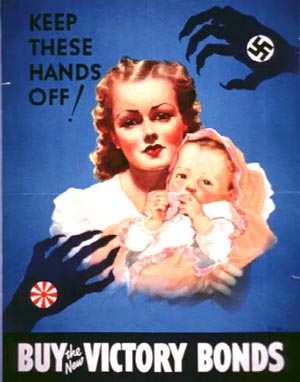Return to Course
Housekeeping:
- Final call for mid-term evaluations.
- My name is not Mr. Heiniger (or Mrs. or Ms.)!! :) :)
Agenda:
Moving to Modernism
The ideological break (from Victorian culture) caused by WWI is also reflected in art. Specifically, Modernism emerges in the 1910s and 1920s.
Let's look at the Modern Art Timeline (created by the Art Factory). Take a few minutes to scroll through it on your own and then we're going to discuss it together.
Discussion Questions:
- What characteristics distinguish something as "Modernism" to you?
- How were these trends beginning long before the Great War?
- What changes after the Great War?
Modernisms:

Wassily Kandinsky (1866 - 1944)
Russian-born painter who emigrated to Germany and later to France. His work is iconic of the Expressionist movement from 1900 - 1944 (bridging the two World Wars).

Kandinsky. "Der Blaue Reider" (1903). Oil painting.

Kandinsky "Reiter" (1911). Oil paint.
Discussion Questions: Kandinsky's Riders
- How does Kandinsky's portrayal of the rider change in these two paintings?
- Based on these two paintings, what can we say about the Expressionist movement? How does it differ from earlier art movements?

Wassily Kandinsky "On White" (1923). Via Wikipedia - http://en.wikipedia.org/wiki/File:Kandinsky_white.jpg#mediaviewer/File:Kandinsky_white.jpg
Discussion Questions: "On White"
- Kandinsky claimed that music was the ultimate inspiration for visual art. Can you see a relationship between this painting and music? What is it?

"Duchamp Fountaine" (1917) by Marcel Duchamp - src Original picture by Stieglitz. Licensed under Public domain via Wikimedia Commons - http://commons.wikimedia.org/wiki/File:Duchamp_Fountaine.jpg#mediaviewer/File:Duchamp_Fountaine.jpg
Discussion Questions: Duchamp's Fountaine
- What is this?
- What sort of message does this image convey?
WWI to WWII: a 25-year Armistice
WWI ended on 11 November, 1918 with an armistice, that is a ceasation of hostilities (not a surrender). The armistice was signed in Compiègne, France in a railway car. This railway car was eventually donated to the French military museum in Paris (later moved to a museum in Compiègne).
Hitler's war with France (initially) ended with a second armistice. In a symbolic reversal of WWI, Hitler used the same railway car in the same location. He sat where the French marshal sat when facing the defeated German Empire. Hitler had the railway car moved to Berlin after the armistice was signed.
While the actual causes of WWII are myriad, this symbolic action really reinforced the idea that WWII was a response to the unresolved tensions (and national humiliations) of WWI.

"Bundesarchiv Bild 183-M1112-500, Waffenstillstand von Compiègne, Hitler, Göring" by Unknown
This image was provided to Wikimedia Commons by the German Federal Archive (Deutsches Bundesarchiv) as part of a cooperation project. The German Federal Archive guarantees an authentic representation only using the originals (negative and/or positive), resp. the digitalization of the originals as provided by the Digital Image Archive.. Licensed under Creative Commons Attribution-Share Alike 3.0-de via Wikimedia Commons - http://commons.wikimedia.org/wiki/File:Bundesarchiv_Bild_183-M1112-500,_Waffenstillstand_von_Compi%C3%A8gne,_Hitler,_G%C3%B6ring.jpg#mediaviewer/File:Bundesarchiv_Bild_183-M1112-500,_Waffenstillstand_von_Compi%C3%A8gne,_Hitler,_G%C3%B6ring.jpg
The SS blew up the railway car before the allies took Berlin. This final action reinforces the symbolic nature of this vehicle for the conflict.
World War Two
Propaganda War:
WWII was a war fought with weapons as well as with ideas. All wars produce propaganda, including WWI. British (and US) propaganda typically demonized the German army, giving moral impetus to what was essentially a territorial dispute. Nations primarily relied upon nineteenth-century nationalism to support the war effort. The disillusionment generated by WWI generated a culture of pacifism and isolationism (a reaction to the alliances and militarism of the previous generation). Thus, the ideological warfare of WWII was much more important to mobilizing troops and civilians in the war effort. It was also important because WWII was not a territorial dispute. It was a war over ideologies about humanity as well as a struggle against imperial conquest.
Group Work:
Use the link below to view the government collection of WWII propaganda posters. Choose a poster. Post it to this page and then comment on it in the box below.
Sink the Bismark
Artistic Responses to the Second World War:
Missing Art:

The poster shows how Canada felt about the war. The Nazis and Japanese are shown with demon hands. So not only were the Nazis evil, Japan was too. The innocent looking white women is holding a baby to further show how vulnerable she is. It seems like it is saying that if you buy the victory bonds, it will protect women and children.
Comments (3)
malghafli@... said
at 5:31 pm on Oct 30, 2014
Kai and Maryam
Waste Helps the Enemy by Vanderlaan
This directly shows the impact from wasting your materials and the impact on the war.
Danielle said
at 2:40 pm on Nov 4, 2014
Danielle and Anthony
"When You Ride Alone You Ride With Hitler!"
This image depicting a man driving alone in a car is used to urge American citizens to conserve gas and energy by carpooling, thus eliminating the number of cars on the road. The image along with the tag line gives the audience the impression that driving alone is a comparable evil to the actions of Hitler.
Gerrit said
at 5:34 pm on Nov 4, 2014
http://www.archives.gov/exhibits/powers_of_persuasion/hes_watching_you/images_html/images/someone_talked.jpg
Gerrit and George
Someone Talked
We feel this picture shows that the fear of helping the enemy in anyway could cause the death of the navy. May refer to the fear of ( pear harbor ) (U-boats)
You don't have permission to comment on this page.